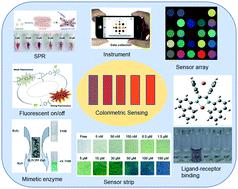当前位置:
X-MOL 学术
›
Environ. Sci.: Nano
›
论文详情
Our official English website, www.x-mol.net, welcomes your
feedback! (Note: you will need to create a separate account there.)
Recent advances in the design of colorimetric sensors for environmental monitoring
Environmental Science: Nano ( IF 5.8 ) Pub Date : 2020-06-18 , DOI: 10.1039/d0en00449a Bin Liu 1, 2, 3, 4 , Jinyin Zhuang 1, 2, 3, 4 , Gang Wei 1, 2, 3, 4
Environmental Science: Nano ( IF 5.8 ) Pub Date : 2020-06-18 , DOI: 10.1039/d0en00449a Bin Liu 1, 2, 3, 4 , Jinyin Zhuang 1, 2, 3, 4 , Gang Wei 1, 2, 3, 4
Affiliation

|
Colorimetric sensors and biosensors exhibit promising potential toward the detection of metallic cations, anions, organic dyes, drugs, pesticides and other toxic pollutants due to their easy fabrication, quick detection, and high sensitivity and selectivity, as well as easy naked-eye sensing. In this work, we present the recent advances (since 2014) made in the fabrication of colorimetric sensors for the environmental monitoring of toxic pollutants. To understand the relationships between the type, structure, and functions of nanomaterials as building units and the sensing performance of the designed colorimetric sensors, the fabrication of several sensor platforms based on functional nanomaterials (such as metal nanoparticles, metal oxides, quantum dots, two-dimensional nanozymes, organic probes, and Schiff bases) are demonstrated and discussed. The sensing mechanisms of the considered colorimetric sensors based on the aggregation of nanoparticles, decomposition of nanoparticles, nanozymes, fluorescence on–off, ligand–receptor interactions, and photonic structures are introduced and discussed in detail. In addition, instrument-based colorimetric sensors and advanced colorimetric sensor products for high-performance environmental monitoring are presented. Finally, the advantages and disadvantages of various colorimetric sensors in environmental monitoring are analyzed and compared. It is expected that this work will be valuable for readers to understand the fabrication and sensing mechanisms of various colorimetric biosensors and promote their development in environmental science, materials science, nanotechnology, food science, and bioanalysis.
中文翻译:

用于环境监测的比色传感器设计的最新进展
比色传感器和生物传感器具有制造,快速检测,高灵敏度和选择性以及易于肉眼感应等优点,因此在检测金属阳离子,阴离子,有机染料,药物,农药和其他有毒污染物方面显示出广阔的前景。在这项工作中,我们介绍了自2014年以来在用于有毒污染物环境监测的比色传感器制造方面的最新进展。为了了解纳米材料作为建筑单元的类型,结构和功能与所设计比色传感器的传感性能之间的关系,基于功能纳米材料的几种传感器平台的制造(例如金属纳米颗粒,金属氧化物,量子点,两种维纳米酶,有机探针和席夫碱)已得到证实和讨论。介绍并详细讨论了基于纳米粒子聚集,纳米粒子分解,纳米酶,荧光开-关,配体-受体相互作用和光子结构的比色传感器的传感机制。此外,还介绍了基于仪器的比色传感器和用于高性能环境监测的高级比色传感器产品。最后,分析比较了各种比色传感器在环境监测中的优缺点。希望这项工作对读者了解各种比色生物传感器的制造和传感机制,并促进其在环境科学,材料科学,纳米技术,食品科学和生物分析中的发展具有宝贵的价值。
更新日期:2020-08-14
中文翻译:

用于环境监测的比色传感器设计的最新进展
比色传感器和生物传感器具有制造,快速检测,高灵敏度和选择性以及易于肉眼感应等优点,因此在检测金属阳离子,阴离子,有机染料,药物,农药和其他有毒污染物方面显示出广阔的前景。在这项工作中,我们介绍了自2014年以来在用于有毒污染物环境监测的比色传感器制造方面的最新进展。为了了解纳米材料作为建筑单元的类型,结构和功能与所设计比色传感器的传感性能之间的关系,基于功能纳米材料的几种传感器平台的制造(例如金属纳米颗粒,金属氧化物,量子点,两种维纳米酶,有机探针和席夫碱)已得到证实和讨论。介绍并详细讨论了基于纳米粒子聚集,纳米粒子分解,纳米酶,荧光开-关,配体-受体相互作用和光子结构的比色传感器的传感机制。此外,还介绍了基于仪器的比色传感器和用于高性能环境监测的高级比色传感器产品。最后,分析比较了各种比色传感器在环境监测中的优缺点。希望这项工作对读者了解各种比色生物传感器的制造和传感机制,并促进其在环境科学,材料科学,纳米技术,食品科学和生物分析中的发展具有宝贵的价值。











































 京公网安备 11010802027423号
京公网安备 11010802027423号